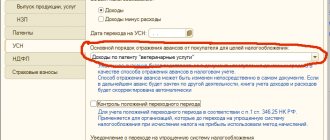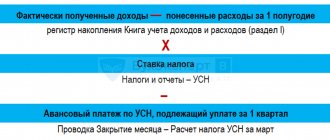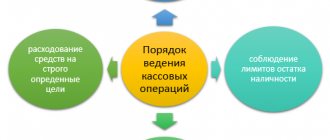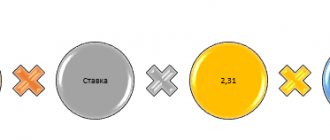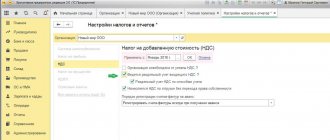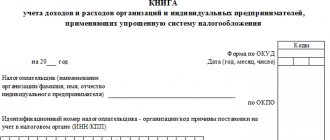An organization can voluntarily switch from the simplified tax system to the special tax system only from the beginning of the new calendar year (clause 3 of article 346.13 of the Tax Code of the Russian Federation). To do this, no later than January 15 of the year from which the organization plans to start using the simplified tax system, submit to the Federal Tax Service a notice of refusal to use the simplified tax system (clause 6 of article 346.13 of the Tax Code of the Russian Federation). The organization will lose the right to the simplified tax system from the beginning of the quarter in which at least one of the following events occurred:
- the organization did not fulfill at least one of the conditions that must be observed by simplifiers (clause 4 of Article 346.13 of the Tax Code of the Russian Federation, Letter of the Ministry of Finance dated December 1, 2015 N 03-11-06/2/70012);
- An organization applying the simplified tax system with the object “income” has entered into a simple partnership agreement (joint activity) or an agreement for trust management of property (clause 3 of article 346.14 of the Tax Code of the Russian Federation, Letter of the Federal Tax Service of February 15, 2016 N SD-4-3 / [email protected] , Ministry of Finance dated May 30, 2012 N 03-11-06/2/73).
After losing the right to the simplified tax system, the organization is considered to have switched to the simplified tax system.
How to make the transition from the simplified tax system to the OSNO in 2021-2022
The simplified tax system and the OSNO are such different taxation systems that it is very difficult to compare them.
OSN provides for the maintenance of full accounting with the accrual and payment of all types of taxes. The simplified tax system allows for the payment of a minimum amount of taxes. How to switch from simplified tax system to OSN? A transition from one tax regime (STS) to another (OSN) is possible in the following cases:
- Termination of the use of the simplified tax system on a voluntary basis when submitting a notification to the tax office (clause 6 of article 346.13 of the Tax Code of the Russian Federation). It must be sent to the Federal Tax Service no later than January 15 of the year from the beginning of which the regime change takes place. The notification is submitted in form No. 26-2-3 (approved by order of the Federal Tax Service dated November 2, 2012 No. ММВ-7-3/829).
Important! It is mandatory to submit a notice of voluntary departure from the simplified tax system, according to the Ministry of Finance. Without doing this, you cannot begin to apply the general taxation regime. You can find out how the latest judicial practice on this issue is shaping up from the analytical collection from K+, having received free access to the system.
- Forced termination of the use of the simplified tax system as a result of exceeding the maximum permissible level of annual income or violation of other conditions for the use of the simplified tax system (clause 4 of article 346.13 of the Tax Code of the Russian Federation). A notice of termination of the use of the simplified tax system is submitted within the first 15 days of the quarter following the one in which the conditions for the use of the simplified tax system were violated. The notification is submitted in form No. 26-2-2 (approved by order of the Federal Tax Service dated November 2, 2012 No. ММВ-7-3/829).
Important! If you are late or do not submit this notice at all, you may be fined 200 rubles. (Clause 1 of Article 126 of the Tax Code of the Russian Federation, letter of the Ministry of Finance dated December 6, 2017 No. 03-11-11/81211). For the director of an organization (chief accountant or other official), an administrative fine of 300 rubles is also possible. up to 500 rub. (Part 1 of Article 15.6 of the Code of Administrative Offenses of the Russian Federation).
What documents and when should be submitted to the Federal Tax Service if the right to the simplified tax system is lost?
After losing the right to use the simplified tax system, you must submit to the Federal Tax Service:
- notification of loss of the right to use the simplified tax system - no later than the 15th day of the month following the quarter in which the right to the simplified tax system was lost (clause 5 of article 346.13 of the Tax Code of the Russian Federation, Letter of the Ministry of Finance dated July 14, 2015 N 03-11-09/40378 );
- declaration under the simplified tax system - no later than the 25th day of the month following the quarter in which the right to the simplified tax system was lost (clause 3 of article 346.23 of the Tax Code of the Russian Federation, Letter of the Ministry of Finance dated July 14, 2015 N 03-11-09/40378).
Starting from the first month of the quarter in which the organization lost the right to the simplified tax system, it applies the simplified tax system (clause 4 of article 346.13 of the Tax Code of the Russian Federation). The first OSN reporting must be submitted to the Federal Tax Service within the following deadlines:
- VAT declaration in electronic form for the quarter in which the right to the simplified tax system was lost - no later than the 25th day of the month following this quarter (clause 5 of article 174 of the Tax Code of the Russian Federation);
- income tax return:
- if the right to the simplified tax system is lost in the 1st, 2nd or 3rd quarter - no later than the 28th day of the month following this quarter - a declaration for the 1st quarter, half a year or 9 months of the calendar year, respectively (clause 3 of Article 289 of the Tax Code of the Russian Federation);
- if the right to the simplified tax system is lost in the fourth quarter - no later than March 28 of the next year - a declaration for the year (clause 4 of article 289 of the Tax Code of the Russian Federation).
In addition, if you have fixed assets that are subject to property tax based on the book value, you must submit a property tax declaration to the Federal Tax Service (calculation of the advance payment).
Such OS include (clause 1, subclause 8, clause 4, article 374, clause 25, article 381 of the Tax Code of the Russian Federation, Letters of the Ministry of Finance dated 07/06/2016 N 03-05-05-01/39563, dated 05/27/2016 N 03-05-05-01/30592): 1) objects of movable property that were accepted for accounting as fixed assets before 01/01/2013 and are classified in accordance with the Classification of fixed assets to depreciation groups from three to ten;
2) objects of movable property that are accepted for accounting as fixed assets starting from 01/01/2013 and meet two conditions:
- in accordance with the OS Classification, they belong to depreciation groups from the third to the tenth;
- received as a result of the reorganization or liquidation of an organization, as well as from a related party;
3) real estate objects that are not subject to property tax based on cadastral value.
For the first time after losing the right to the simplified tax system, a property tax declaration (calculation of the advance payment) must be submitted:
- if the right to the simplified tax system is lost in the 1st, 2nd or 3rd quarter and the law of your constituent entity of the Russian Federation establishes reporting periods for property tax - no later than the 30th day of the month following the quarter in which the right to the simplified tax system was lost - calculation of the advance tax payment on property for this quarter (clauses 2, 3 of Article 379, clause 2 of Article 386 of the Tax Code of the Russian Federation);
- if the right to the simplified tax system was lost in the fourth quarter or the law of your constituent entity of the Russian Federation does not establish reporting periods for property tax - no later than March 30 of the next year - a property tax declaration (clauses 1, 3, article 379, clause 3, art. 386 of the Tax Code of the Russian Federation).
What does it mean to “go wild”?
“Flying off the simplified system” is what people call the loss of the right to use the simplified tax system. To do this, you need to exceed at least one of the taxpayer’s performance indicators:
- OS cost - 150 million rubles. in 2021-2022;
- average number of employees - 130 people;
- established income limit: in 2022 - 200 million rubles, for 2021 this amount is indexed and amounts to 219.2 million rubles;
For new rules for applying income and headcount limits from 2022, see our article.
- start engaging in activities incompatible with the simplified tax system, for example, producing excisable goods, organizing a pawnshop (clause 3 of article 346.12 of the Tax Code of the Russian Federation);
- acquire a branch (in this case, the presence of a representative office or other separate division does not interfere with the use of the simplified tax system);
- exceed the 25 percent share of participation of legal entities in the management company of a simplified company;
- become a participant in a simple partnership agreement or trust management of property (clause 3 of Article 346.14 of the Tax Code of the Russian Federation).
If you lose the right to use the simplified tax system, you need to calculate and pay the taxes used under the OSNO. This is done according to the rules that are prescribed in the Tax Code of the Russian Federation for newly created organizations or newly registered individual entrepreneurs. You will not have to pay fines and penalties for late payment of monthly payments during the quarter in which you switched to OSNO.
During the transition period from the simplified tax system to the OSN, it will be necessary to determine:
- The amount of accounts receivable, since under the cash method and under the accrual method, income will differ.
- Accounts payable for taxes, employee salaries, and to suppliers.
- Outstanding accounts payable.
- Residual value of the property.
All these indicators will help in calculating tax bases and taxes themselves.
How to calculate and pay taxes, as well as submit reports in case of loss of the right to the simplified tax system, is explained in detail in the Ready-made solution from ConsultantPlus. If you do not yet have access to the system, get it absolutely free and go to the material.
What to do if the tax office has reported non-compliance with the conditions of the simplified tax system, read here.
Features of the transition from a simplified taxation system to a general one: we recognize income and expenses
Revenue unpaid under the simplified tax system must be included in income in the 1st month of application of the simplified tax system (subclause 1, clause 2, article 346.25 of the Tax Code of the Russian Federation, letter of the Federal Tax Service of the Russian Federation dated 01/09/2018 No. SD-4-3/6).
All advances that the “simplified” person received before the transition from the simplified tax system to the OSNO are included in the taxable base for a single tax. This is done even if the goods are shipped in advance after the transition from the simplified tax system to the general taxation system (subclause 1, clause 1, article 251 of the Tax Code of the Russian Federation). The costs of such shipment will reduce the income tax base (letter of the Ministry of Finance dated January 28, 2009 No. 03-11-06/2/8).
Expenses during the transition from the simplified tax system to OSNO (in the first month of application of the new regime) include unpaid debt for services rendered (subclause 2 of clause 2 of article 346.25 of the Tax Code of the Russian Federation), unpaid wages and unpaid insurance premiums (letters from the Ministry of Finance of the Russian Federation dated 05/03/2017 No. 03-11-06/2/26921, dated December 22, 2014 No. 03-11-06/2/66188).
The Tax Code of the Russian Federation does not link the possibility of classifying unpaid goods, works, and services as expenses under the simplified tax system with the use of one or another object of taxation under the simplified tax system (“income” or “income minus expenses”). That is, expenses that were incurred when applying the simplified tax system, including with the object “income,” but were paid after the transition to OSNO, are taken into account when calculating income tax. The procedure for accounting for expenses on goods causes controversy. In order to take into account the costs of them for the simplified tax system, the goods must not only be paid for, but also sold. Therefore, goods that were purchased and paid for under the simplified tax system, and sold after the transition to OSNO, are allowed by senior judges to be taken into account during the period of their sale, that is, when calculating income tax (letter of the Federal Tax Service of the Russian Federation dated 01/09/2018 No. SD-4-3/6 , ruling of the Supreme Court of the Russian Federation dated March 6, 2015 No. 306-KG15-289). Previously, the Ministry of Finance expressed a different position - expenses should be taken into account on the date of transition (letter dated July 31, 2014 No. 03-11-06/2/37697). Now the position of the department coincides with the opinion of the Supreme Court (letters of the Ministry of Finance of the Russian Federation dated November 14, 2016 No. 03-03-06/1/66457, dated January 22, 2016 No. 03-03-06/1/2227). This is especially beneficial for those who used the simplified tax system with the object “income”, because before switching to OSNO they cannot use expenses to reduce tax.
If a taxpayer has accounts receivable using the simplified tax system, the return of which is impossible, then losses from their write-off are not taken into account. It cannot reduce the tax base for the simplified tax system (Article 346.16 of the Tax Code of the Russian Federation) and attribute it to expenses for the special tax system (subclause 2 of clause 2 of Article 346.25 of the Tax Code of the Russian Federation) will also not work (letter from the Ministry of Finance dated February 20, 2016 No. 03-11-06 /2/9909, dated June 23, 2014 No. 03-03-06/1/29799).
Read about the procedure for accounting for expenses during a voluntary transition from the simplified tax system to the OSN in the material “From the simplified tax system to the OSN: adding up last year’s expenses.”
Accounting for income and expenses
Being on a simplified system, taxpayers account for income and expenses in accordance with the cash method - based on cash flow. This means that income is recognized when money comes in, expenses when payments go out. On OSNO, along with cash accounting, there is accrual accounting. With it, income and expenses are recognized in the period in which the transaction was performed, and the actual cash flow does not play a role.
To apply the cash method on the main system, there is a limitation on sales revenue for the previous four quarters. On average for each period, its amount should be no more than 1 million rubles. If the revenue is higher, then you need to switch to the accrual method. It is the main one and is used by most companies.
Free tax consultation
If an organization begins to calculate income and expenses using the accrual method, it must adhere to the following rules during the transition period:
- Accounts receivable should be reflected in the income for the first month of OSNO. These are the amounts that suppliers had to transfer for goods shipped to the simplified tax system. At that time, these incomes were not taken into account, because the cash method was used. Now the accrual method is used, and since the goods have already been shipped, it means that income from their sale must be taken into account.
- If at the time of transition there are advances received for which delivery has not yet been made, then there is no need to take them into account when calculating income tax. These amounts are taken into account in income taxed under the simplified tax system, since at the time of their receipt the cash method was in effect.
- The expenses of the first month in the main mode must reflect the amount of outstanding accounts payable. The reasons are the same - the previous use of the cash method, in which these expenses were not taken into account. Thus, debt to the budget, counterparties or employees will reduce the income tax base.
- It is impossible to write off as expenses the bad receivables formed under the simplified tax system. If it is recognized as such after the transition, then it can be taken into account in expenses.
- Production costs and expenses for purchasing goods for resale are written off after the products or goods are sold. If a company incurred such costs for the simplified tax system, but did not have time to sell finished products before the transition, then its cost can be taken into account in income tax expenses. Moreover, it does not matter which simplified object was previously selected. In other words, the simplified tax system, after switching to OSNO, will be able to write off such costs. This is very beneficial, since there was no such opportunity on the simplified tax system.
Let's see how to take into account some of the operations of Orange LLC. In the 2nd quarter, it delivered a consignment of goods worth 500 thousand rubles, but payment for it has not yet been received. An advance in the amount of 1 million rubles was received from another buyer. In addition, by the time of the transition, the LLC had accumulated a debt to the supplier in the amount of 100 thousand rubles.
When calculating income tax for the period from July 1 to September 30, 2019, you need to include:
- in income - accounts receivable in the amount of 500 thousand rubles;
- expenses - payable in the amount of 100 thousand rubles.
The advance payment will not be included in the income tax base, because there has been no delivery for it yet. However, it must be included in income when calculating the tax base according to the simplified tax system.
What was said above about accounting for income and expenses is true for organizations. Regarding individual entrepreneurs, the question is not easy. The Federal Tax Service has traditionally been of the opinion that individual entrepreneurs can only use the cash method. After all, instead of income tax, they pay personal income tax, and it does not provide for accrual accounting. However, the courts in such cases often side with entrepreneurs and recognize the use of this method as lawful.
Determination of the residual value of fixed assets and intangible assets during the transition from the simplified tax system to the OSNO
If the simplifier makes the transition to OSNO voluntarily from the beginning of next year, then problems with fixed assets do not arise. Property purchased under the simplified tax system is written off in equal shares during the tax period - a year.
If the transition from the simplified tax system occurs before the end of the year, the balance of the cost of the acquired fixed asset will be recorded. With the object “income minus expenses”, this balance of the property value not written off as “simplified” expenses must be transferred to tax accounting on OSNO as the residual value of fixed assets (letter of the Ministry of Finance of the Russian Federation dated March 15, 2011 No. 03-11-06/2/34). When switching to OSNO from the simplified version with the object “income”, you also have the right to determine the residual value of the OS (clause 3 of Article 346.25 of the Tax Code of the Russian Federation, clause 15 of the Review approved by the Presidium of the Supreme Court of the Russian Federation on July 4, 2018, letter of the Ministry of Finance dated June 14, 2019 No. 03 -04-05/43643, Federal Tax Service dated July 30, 2018 No. KCH-4-7/14643). To do this, from the original cost of the object, you need to subtract the expenses that could have been incurred if you had used the object “income minus expenses”.
Examples of calculating the residual value of fixed assets for each of these cases can be viewed by obtaining free access to ConsultantPlus.
The Tax Code of the Russian Federation has a rule on calculating the residual value of fixed assets and intangible assets when switching from the simplified tax system to the OSNO. It concerns objects that were acquired before the application of the simplified tax system during the period of work at OSNO. That is, they bought property on OSNO, then switched to the simplified tax system, and then returned to OSNO. On the date of return to income tax, the tax residual value of fixed assets and intangible assets is calculated as the difference between the residual value of these objects upon transition to the simplified tax system and the expenses written off during the period of application of the simplified tax system (clause 3 of Article 346.25 of the Tax Code of the Russian Federation).
For more information about fixed assets, see this article.
Limits and restrictions on the simplified tax system
Now let’s look at what conditions you can lose for violating the right to a simplified license. Most often this happens due to exceeding the income limit. Paragraph 4 of Article 346.13 of the Tax Code of the Russian Federation states that this is 150 million rubles based on the results of the reporting or tax period. That is, the transition from the simplified tax system to the OSNO in 2022 will occur if, at the end of any quarter or the entire year, the amount of income taken into account on an accrual basis exceeds this figure.
In addition, you can lose your right to preferential treatment for the following reasons:
- the average number of employees per year exceeded 100 people;
- the organization opened a branch;
- the share in the company owned by another legal entity exceeded 25%;
- the residual value of fixed assets exceeded 150 million rubles;
- the organization began to engage in business that is prohibited for the simplified tax system (for example, producing excisable goods);
- a company using the simplified tax system with the object “Income” has entered into a simple partnership or entered into a property trust management agreement.
The restrictions for the use of the simplified tax system are described in detail in paragraph 3 of Article 346.12 of the Tax Code of the Russian Federation.
The Ministry of Finance proposes to increase the limits on income and the number of employees from 2022, as well as introduce additional increased tax rates. If this is ultimately approved, the following procedure will apply:
- If the number of employees is no more than 100 people and / or income is no more than 150 million rubles, the previous rates will be applied - 6% for the simplified tax system for income and 15% for the object “Income minus expenses”.
- If the number of employees is 101-130 people and / or income is from 150 to 200 million rubles, rates of 8% and 20% will be applied.
- If you go beyond the upper values from point 2, the simplification cannot be used.
The increased rates will remain in effect until the end of the year in which the limit was exceeded, as well as the entire next year. If at the end of it the number of employees / income fits into the amounts specified in paragraph 1, then the rate is reduced to the standard one.
VAT upon transition from simplified tax system to OSNO
When the application of the simplified tax system is terminated (regardless of the reason for this termination), the company or individual entrepreneur becomes a VAT payer and acquires the obligation to accrue it. During the transition period, you need to take into account when the money arrived. If an advance payment for a product was received before the transition to OSNO, and its purchase occurred later, then VAT must be charged only on sales. If an advance is received after the transition from the simplified tax system to OSNO, VAT is calculated from the amount of the advance and accrued for sale. Moreover, after shipment, VAT on the advance payment can be included in deductions.
Read more about the rules for VAT refund on a simplified basis in this article .
See also the article “What to do with “input” VAT on fixed assets when transitioning from the simplified tax system to the general taxation regime?”.
When switching from the simplified tax system, VAT must be charged from the beginning of the quarter in which the transition to OSNO took place, even if this happened in the last month of the quarter. The company must calculate and pay tax to the budget for the entire quarter.
If there are non-current assets
Write-off of the value of fixed assets and intangible assets in the basic and simplified systems is carried out differently. Therefore, if there is property, the costs of which are still subject to write-off, during an emergency transition you need to calculate its residual value. It must be transferred to tax accounting on OSNO for subsequent depreciation.
This only applies to those companies that are switching to a traditional system from a simplified system with the object “Revenue minus expenses”. If you used the simplified tax system for income, you do not need to calculate the residual value, since this tax regime does not involve accounting for expenses.
If the object was purchased under the main tax system before the organization switched to the simplified one, then the residual value must also be calculated. The formula is applied: the amounts written off under the simplified system are subtracted from the residual value on the date of transition to the simplified tax system.
If you transfer voluntarily, no additional actions need to be taken. The fact is that the value of property when applying the simplified system is written off until the end of the year in which it was acquired. A voluntary transition is possible only from the beginning of next year, and by that time everything will have been written off.
So, when switching to OSNO from the simplified version in the middle of the year, there are a number of nuances. The company cannot always control the parameters of applying the simplified tax system, especially revenue. Therefore, it is quite easy to lose the right to this preferential treatment. You can return only after a year. Thus, if the right is lost this year, it will be possible to apply the simplified tax system again no earlier than 2022.
Invoices during the transition from the simplified tax system to the OSNO
It is necessary to pay attention to the fact that re-issuance of invoices with the inclusion of VAT is possible only for those shipments whose issuance period (5 days) expires in the month when the transition to OSNO became necessary. This is regulated by the fact that invoices from the date of shipment are issued exactly within this period (clause 3 of Article 168 of the Tax Code of the Russian Federation). Similar explanations are given by the letter of the Federal Tax Service dated 02/08/2007 No. MM-6-03/ [email protected] If the seller loses the right to the simplified tax system, then he will have to pay VAT at his own expense. It will not be possible to take this amount into account in expenses for income tax (Article 170, paragraph 19 of Article 270 of the Tax Code of the Russian Federation).
Some arbitration courts come to the conclusion that it is correct to re-issue invoices with the allocation of VAT from the beginning of the entire tax period for VAT, which includes the loss of the right to the simplified tax system (Resolution of the Federal Antimonopoly Service of the Volga District dated May 30, 2007 No. A12-14123/06-C29 was supported by the YOU RF in definition dated 06.08.2007 No. 9478/07).
Let's move on to OSNO: possible situations
Let's look at the cases that occur in practice when changing one tax regime to another, and see what will happen to VAT in one case or another.
- The company, being on the simplified tax system, sold goods, but payment for them was received later - after the company switched to OSNO. Moreover, it does not matter for what reason this transition is associated - simply when the regime changes at the request of the company itself or when it loses the right to the simplified tax system. In such a situation, according to paragraph 3 of Art. 346.11 of the Tax Code of the Russian Federation, VAT is not calculated, and the payment received is not included in the base for this tax, since the company was not a VAT payer directly at the time of sale. This, in particular, is stated in the letter of the Ministry of Finance of the Russian Federation dated March 12, 2010 No. 03-11-06/2/33.
- The opposite case: the company received an advance from the buyer while it was on the simplified tax system, and the sale of the paid goods occurred after the transition to the simplified tax system. In this situation, the enterprise has the obligation to calculate VAT and pay it to the budget. And of course, in this case it is necessary to issue the buyer an invoice with the allocated tax amount - and this must be done within 5 days from the date of issue of goods and materials or provision of services. This follows from the letter of the Ministry of Finance dated May 24, 2018 No. 03-07-11/35126.
It is clear that of these two situations, the second is more complex and ambiguous. In the letter we indicated, officials considered the situation with the meeting with the simplified tax system. It appears that their conclusions are valid if the advance was received in the same period. Then it will not be included in the simplified tax system, but will only be subject to VAT. Well, what if it was received at an earlier time? Then it turns out that you have already paid an advance on it under the simplified procedure, and now you still have to pay VAT on the shipment. In our opinion, this is not very correct. Therefore, we believe that if you received an advance during the period of application of the simplified tax system, for example, in December 2021, and shipped goods (performed a service) during the period of application of the simplified tax system, for example, in January 2022, then VAT on the advance received in December 2022 There is no need to calculate and pay into the budget.
Results
You can switch from the simplified tax system to the general taxation system on a voluntary basis from the beginning of the new year or if you lose the right to a simplified tax system. As a result of this, the volume of both accounting and tax accounting will increase, as well as the number of taxes paid.
Sources:
- Tax Code of the Russian Federation
- Review of judicial practice of the Supreme Court of the Russian Federation No. 2 (2018)
You can find more complete information on the topic in ConsultantPlus. Free trial access to the system for 2 days.
Losses
If a company incurred a loss during the application of the simplified tax system, then after returning to the general regime it cannot take it into account in tax accounting.
But by the amount of losses received before the application of the simplified tax system (on the general taxation system), you can reduce taxable profit.
How to write off such losses is described in Article 283 of the Tax Code.
Let’s take a closer look at accounting for losses during the period the company applied the simplified tax system.
Let’s assume that an organization applied the simplified tax system with the object of taxation “income minus expenses” last year, as a result of which it incurred a loss.
Since the beginning of this year, the company has switched to a common taxation system. However, starting next year, the organization again plans to operate on the simplified tax system with the object “income minus expenses.” Can an organization take into account a loss incurred last year in the expenses of the next year, in which it plans to switch to the simplified tax system? In letter dated November 5, 2011 No. 03-11-06/2/55687, the Ministry of Finance believes that it can.
The fact is that a “simplified person” with the object of taxation “income minus expenses” has the right to reduce the tax base for a single tax by the amount of loss received as a result of previous tax periods in which the simplified tax system was applied with the same object of taxation (clause 7 of article 346.18 Tax Code of the Russian Federation). The loss can be carried forward for 10 years following the year in which it was incurred.
If for some reason the loss is not carried forward to the next year, it can be carried forward in whole or in part to any year of the next nine years.
If losses are received in several tax periods, then they are carried forward to subsequent years in the order in which they were received.
But the loss received when applying other taxation regimes cannot be taken into account in expenses after the transition to the simplified tax system.
Similarly, when switching from the simplified tax system to the special tax system, it is impossible to take into account losses incurred during the period of application of the simplified tax system with the object of taxation “income minus expenses” (paragraph 8, paragraph 7, article 346.18 of the Tax Code of the Russian Federation). But this can be done based on the results of the tax period in which the company (entrepreneur) will again begin to apply the “income-expenditure” simplified tax system, if by that time ten years have not expired from the date of receipt of the loss.
Consequently, financiers believe, a taxpayer who intends to apply the simplified tax system next year has the right to reduce future “simplified” income by the amount of losses he received earlier during the period of application of the simplified tax system with the object of taxation “income minus expenses.”
